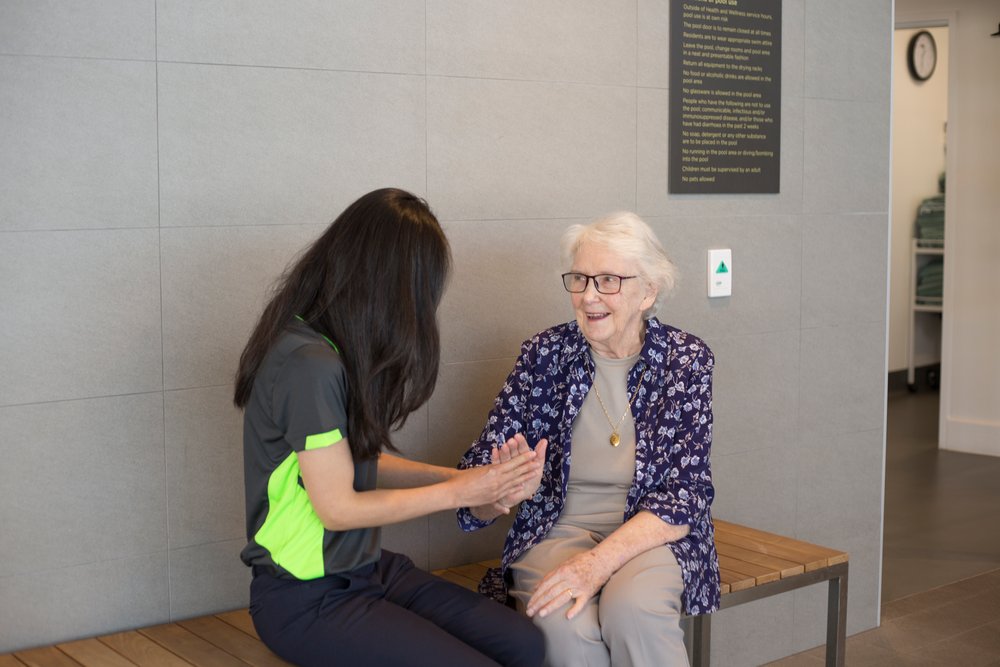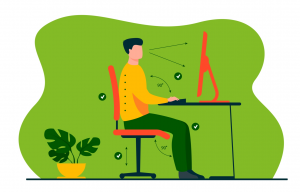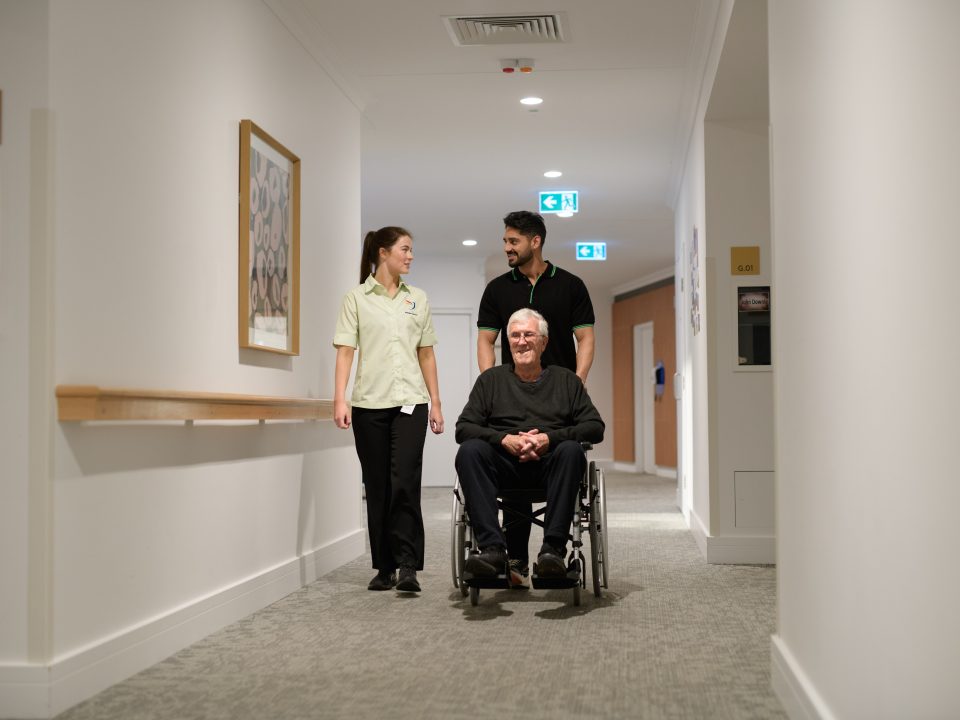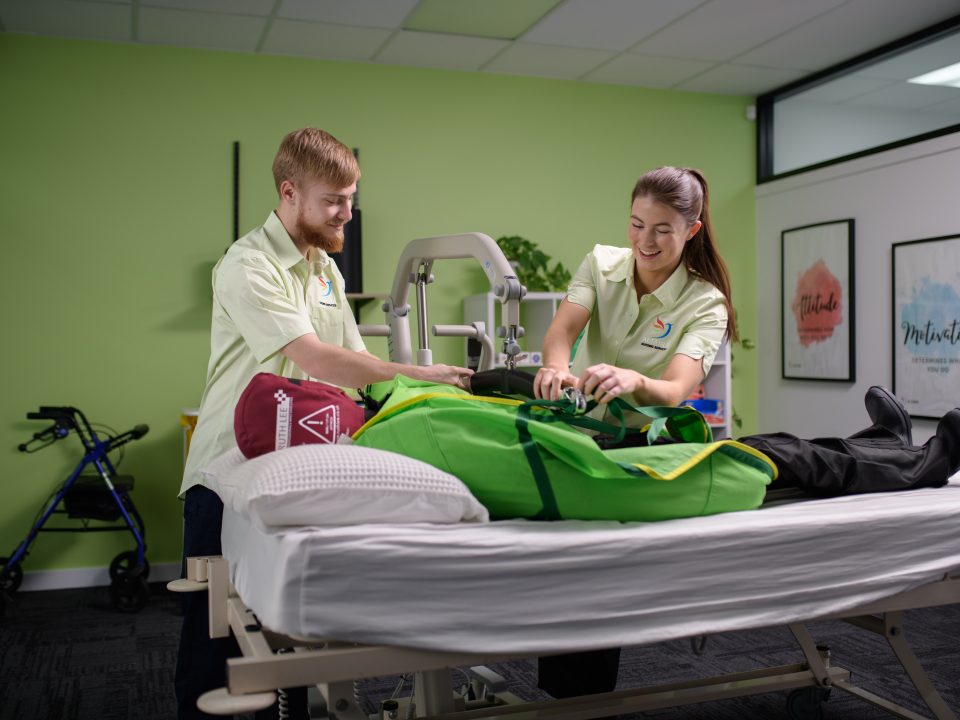
Mental Health Week – How to look after your mental health
October 8, 2021
Healthy Ageing – How Allied Health are Helping
November 21, 2021How to set up your working from home station ergonomically

For many of us, sitting at a desk all day is unavoidable and can leave your body feeling stiff and sore. It’s important to have your computer set up correctly to avoid any neck and lower back issues related to poor ergonomics. Most workplaces look after for this for their employees; however, the pandemic has led to many people working from home and away from their well-set-up desks. As tempting as it may be to sit on the comfy couch or do some work in bed on a cold day, your body would much rather prefer sitting at a desk or table that you’ve spent the time setting up correctly. We’ve provided some useful tips below on how you can work from home and look after your body too.
Where should I set up my desk?
• in a quiet environment with minimal distractions
• desk parallel to window to avoid glare
• where you can adjust natural light with blinds etc
• where you have adequate and even lighting in order to be able to see documents/books
• with all frequently used items (e.g. pen, paper, phone, headset, mouse, keyboard, water bottle, etc.) within reach

What type of chair is best?
• a chair that is height adjustable (as most desks / workstations are a set height)
• a chair with an adjustable back tilt and a 5 star base of support
• preferably with no arms to allow you to move closer to the screen and further under the desk
• high backed for back support and with a lumbar support
• if this is not available then place a rolled-up towel or cushion in the small of your back
How should I position myself and my computer?
• get the height right. Adjust chair height so that your elbows sit comfortably at a right angle (90 degrees)
• if your feet cannot touch the floor, use a foot stool or something to rest your feet on so they are flat and supported
• when sitting, hips should sit at approximately at an angle of 100-120 degrees or just greater than a right angle – this can be achieved by adjusting the seat pan tilt and backrest if your chair is able and knees should be at approximately a 90 degree angle
• monitor should sit one arm length away to allow for easy viewing / reading
• top of computer screen (i.e. taskbar at top of screen) should be at eye level
• of your forearms are supported on the desk – this is then the position of your keyboard, making sure it is lined up directly in front of you. Your fingers should rest comfortably on the middle row of the keyboard.
• place mouse close to keyboard
• sit with body as close to desk as possible, ensure head and neck are forward facing and avoid sitting at an angle to your monitor
• If you use dual monitors position yourself either evenly between them if use them on a 50:50 ratio; or directly in front of one screen if you have a main screen and a reference screen
• ensure back is supported by backrest on chair
• adjust the tilt of the keyboard (achieved by folding or unloading keyboard legs) to a comfortable position for wrist and fingers
• if able, use a keyboard without a numeric pad, allowing mouse to be in closer reach
• tilt computer screen to decrease glare
What about laptops?
• laptops should be used for short periods of time only.
• it is best that they are placed on a laptop riser or stand, so that the top of the laptop screen is at eye level.
• an external keyboard and mouse will be required and should be set up the same as for PC
Other Useful Tips
• adjust the font size or screen view of your documents to allow for easy reading and to avoid eye fatigue
• use headphone (+/-) microphone instead of holding or cradling phone
• use a document holder for documents / books. This should be placed close to screen and at the same height and distance as computer screen
• use a light-coloured background or wearing blue-light glasses to avoid eye fatigue and glare
• standing desks can be very useful in order to break up prolonged sitting positions and set up in same position as for PC on standard desk. A small footstool and alternating placement of feet on stool can help prevent back pain.
• Take regular breaks. Get up and move around and adjust your eyes by looking into the distance
• A good ergonomic set up is important for preventing the build up of chronic pain / injuries associated with sedentary roles. However, it is just as important that you move around as much as possible and readjust your posture regularly as sustained positions of any nature can lead to pain. Always remember – your best posture is your next posture!
What exercises can I do to prevent the development of sore neck and shoulders?
It is important to change your position (stand up or perform a few simple exercises) after every school lesson or after approximately one hour.
Here are four simple exercises to perform several times a day:
1. Chin tuck
• Sit up straight in a chair and look directly ahead of you
• Tuck your chin in without tilting your head down
• Return your head to the original position
2. Neck Sideways Stretch
• Lift one arm and bring it up and across your head
• Sit straight and place the palm of your hand on your head
• use your hand to pull your head gently down towards your shoulder until a stretch is felt on the opposite side
• maintain position for 30 seconds
3. Shoulder blade squeezes
• Clasp your hands in front of you
• squeeze your shoulder blades back and down towards your spine
• hold for 10-20 seconds
4. Active Pelvic Tilt
• sit on chair with your thighs parallel to the ground, your feet flat on the floor and your back in a neutral position
• slowly tilt your hips posteriorly by rounding your lower back and pushing the small of your back into the chair’s backrest
• return pelvis to neutral position
5. High Marching
• this can be performed in either sitting or standing
• perform a seated or standing high march by bringing your thighs up towards your chest as high as possible as if you are performing a high march
• march on the spot alternating with left and right leg for 30 seconds to one minute
If you are experiencing any pain or discomfort while working, contact our brand-new Allied Health and Wellness Centre for a booking on 08 8344 6400. Our dedicated team will not only treat the pain; they will also work with you to find solutions so you can avoid it happening again in the future.










